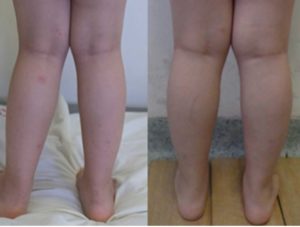Let’s imagine we have a few children coming into the clinic today, each with their own unique symptoms.
Patient A: A 2-year-old has severe bowing of the legs
Patient B: A 4-year-old presents with night blindness and foamy deposits on the nasal and temporal conjunctiva.
Can a good dietary history reveal their possible vitamin or mineral deficiency as the cause of their symptoms?
Patient A

Patient B

Vitamin D
Vitamin D is found in fortified milk, egg yolk, fish liver oils, and through exposure to sunlight.
Vitamin D deficiency can lead to rickets, a disease characterized by decreased bone mineralization, and leading to many skeletal features such as: frontal bossing, craniotabes (a thinning of the outer table of skull), rachitic rosary (a palpable enlargement of the costochondral junctions), Harrison’s groove (a horizontal depression along the lower border of chest), pectus carinatum, widening of the wrist, kyphoscoliosis as well as exaggerated genu valgum and genu varum. Deficiency of this vitamin can also lead to tetany and poor growth.
Treatment
Treatment involves the administration of Vitamin D3 (cholecalciferol) since it is preferred for its bioavailability as compared to Vitamin D2 (ergocalciferol). The dose used will depend on the degree of deficiency (e.g., severe deficiency, deficiency, or insufficiency). An Endocrinology consult may be needed depending on the degree of deficiency, age of patient, and underlying etiology.
For specific dosing, please review the two following guidelines:
- Full CHLA Vitamin D Supplementation Guide (in English)
- Armenian Pediatric Association Guidelines of Vitamin D deficiency management among children – 2017 (in Armenian)
Vitamin A
A study from 2005 suggests that due to the regular consumption of dairy products and fortified vegetable oils, vitamin A deficiency was not a public health concern in Armenia. Nevertheless, it’s important to be able to recognize Vitamin A deficiencies.
Vitamin A is found in many foods such as liver, fish oils, whole milk, egg yolk, as well as green, orange and yellow vegetables.
Deficiency of Vitamin A can present with symptoms related to the eye, such as night blindness, dryness of the conjunctiva and ulceration of the cornea. Bitot’s spots are foamy deposits that may appear on the nasal and temporal conjunctiva. Dryness of the skin, susceptibility to infections, and growth and development problems may occur as well.
Hypervitaminosis A (excess vitamin A, typically caused by taking too many supplements) can present with irritability, abdominal pain, poor weight gain, bone pain, hepatomegaly, increased intracranial pressure, alopecia, mouth ulcers, and peeling of the palms and soles.
Treatment
Vitamin A deficiency treatment varies depending on the symptoms, and etiology. Deficiency dosing will vary based on age and degree of deficiency, and if there is associated xerophthalmia versus those without corneal changes.
Supplementation may also be indicated in specific circumstances, such as patients with measles. Specific dosing regimens will vary if the child is hospitalized or not, and if there are associated ophthalmologic problems.
Differential Diagnosis
Patient A: The differential diagnosis for a child with progressive or severe bowing can include Blount’s disease or severe internal tibial torsion, but one should consider rickets when the history may suggest Vitamin D deficiency in the right age group.
Patient B: Night blindness (nyctalopia) is typically a symptom of an underlying problem involving the eye. The differential diagnosis can include myopia, glaucoma, cataracts, retinitis pigmentosa and vitamin A deficiency. The presence of Bitot’s spots on examination makes vitamin A deficiency a likely etiology.
Hope this helps!
Best regards,
Eyal Ben-Isaac, MD, Children’s Hospital Los Angeles




